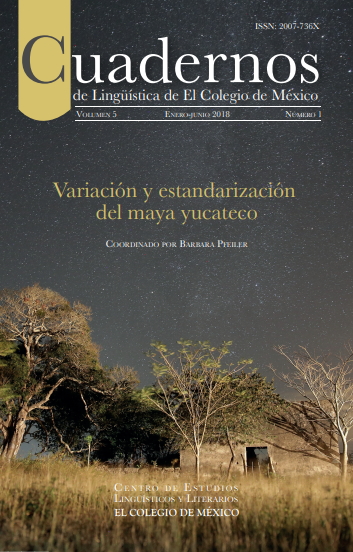<em>Ujuum paayalchi’ ‘The sound of prayers’: New perspectives for the study of Maya ritual discourses, their vocalic qualities and variations.</em>
DOI:
https://doi.org/10.24201/clecm.v5i1.105Keywords:
linguistic anthropology, Yucatec Maya, ritual discourse, automatic alignment, phonetic segmentation, tempo, speech rhythm, variation.Abstract
In this paper, we present new tools and new perspectives for the study of the vocal properties of Yucatec Maya ritual speech. The methodology that we propose is the fruit of interdisciplinary work between linguistic anthropology and spoken language processing. This collaboration allowed us to develop systematic analysis of the vocal temporal structure of ritual enunciations in Yucatec Maya, with the creation of a program of automatic segmentation dedicated to this language. Automatic segmentations were used to measure tempo changes,durations of breath units as well as to examine their link with the structure of the ritual text. Thanks to these new tools, we can test hypotheses relative to the different levels of variability constitutive of Maya ritual speeches as well as to the performative role of vocal variations. Our ambition is twofold: to contribute to a more holistic and multimodal understanding of ritual action and speech and to provide new comparative data from an under-studied language for the broader understanding of rhythmicality of speech across languages and discourse genres.Downloads
References
Auer, Peter & Couper-Kuhlen, Elizabeth & Müller, Frank. 1999. Language in time: Rhythm and tempo of spoken interaction. Oxford: Oxford University Press.
Barth-Weingarten, Dagmar & Reber, Elisabeth & Selting, Margret (eds). 2010. Prosody in interaction. Ámsterdam: John Benjamins. DOI: 10.1075/sidag.23
Bartolomé, Miguel Alberto. 1988. La dinámica social de los mayas de Yucatán. Pasado y presente de la situación colonial. México: INI (Instituto Nacional Indigenista).
Couper-Kuhlen, Elizabeth. 1993. English speech rhythm: Form and function in everyday verbal interaction. Ámsterdam: John Benjamins. DOI: 10.1075/pbns.25
Couper-Kuhlen, Elizabeth. 2009. Relatedness and timing in talk-in-interaction. En Barth-Weingarten, Dagmar & Dehé, Nicole & Wichmann, Anne (eds.), Where prosody meets pragmatics, 259–278. Bingley: Emerald Group Publishing Ltd. DOI: 10.1163/9789004253223_012
Frazier, Melissa. 2009. The production and perception of pitch and glottalization in Yucatec Maya. Chapel Hill: University of North Carolina. (Tesis doctoral).
Furbee, Louanna. 1988. To ask one holy thing: Petition as a Tojolabal Maya speech genre. En Brody, Jill & Thomas, John S. (eds.), Tojolabal Maya: Ethnographic and linguistic approaches, 39–53. Baton Rouge: Louisiana State University Press.
Gossen, Gary. 1974. To speak with a heated heart: Chamula canons of style and good performance. En Bauman, Richard & Sherzer, Joel (eds.), Explorations in the ethnography of speaking, 389-416. Londres: Cambridge University Press. DOI: 10.1017/ CBO9780511611810.025
Guaïtella, Isabelle. 1999. Rhythm in speech: What rythmic organizations reveal about cognitive processes in spontaneous speech production versus reading aloud. Journal of Pragmatics 31. 509-523.
Gussenhoven, Carlos & Teeuw, Renske. 2008. A moraic and a syllabic H-tone in Yucatec Maya. En Herrera, Esther & Martín Butragueño, Pedro (eds.), Fonología instrumental: patrones fónicos y variación. 49–72. México: El Colegio de México.
Hanks, William F. 1984. Sanctification, structure and experience in aYucatec ritual event. Journal of American Folklore 97(384). 131–166. DOI: 10.2307/540182
Hanks, William F. 1993. The five gourds of memory. En Becquelin, Aurore & Molinié, Antoinette (eds.), Mémoire de la tradition, 319– 346. Nanterre: Société d’Ethnologie.
Hanks, William F. 1999. Copresence and alterity in a Maya ritual practice. En Hanks, William F. (ed.), Intertexts: Writings on language, utterance and context, 221–248. Lanham, MD: Rowman & Littlefield Publishers, Inc. (Publicación original: Copresencia y alteridad en la práctica ritual maya. En Léon Portilla, Miguel & Gutiérrez Estevez, Manuel & Gossen, Gary & Klor de Lava, J. Jorge (eds.), De palabra y obra en el Nuevo Mundo, vol. 3, Madrid: Siglo XXI de España Editores).
Hanks, William F. 2006. Joint commitment and common ground in a ritual event. En Enfield, Nick J. & Levinson, Stephen C. (eds.), Roots of human sociality: Culture, cognition and human interaction, 299–328. Oxford: Berg.
Haviland, John B.. Warding off witches: Voicing and dialogue in Zinacantec prayer. En Monod Becquelin, Aurore & Erikson, Philippe (eds,), Les rituels du dialogue, 367–400. Nanterre: Société d’Ethnologie.
Hymes, Dell. 1977. Discovering oral performance and measured verse in American Indian narrative. New Literary History 7. 431–457. DOI: 10.2307/468294
Hymes, Dell. 1981. “In vain I tried to tell you”: Essays in native American ethnopoetics. Filadelfia: University of Philadelphia Press.
Kidder, Emilie. 2013. Prominence in Yucatec Maya: The role of stress in Yucatec Maya words. Tucson: The University of Arizona. (Tesis doctoral.)
Krämer, Martin. 2001. Yucatec Maya vowel alternations – harmony as syntagmatic identity. Zietschrift für Sprachwissenschaft 20. 175–217. Kügler, Frank & Skopeteas, Stavros, & Verhoeven, Elizabeth. 2007. Encoding information structure in Yucatec Maya: On the interplay of prosody and syntax. Interdisciplinary Studies on Information Structure 2007(8). 187–208.
Laver, John. 1994. Principles of phonetics. Cambridge: Cambridge University Press.
Madrid, Edgar. 2008. Hacia el establecimiento de unidades para la medición de la velocidad de habla: el caso del español. En Herrera Zendejas, Esther & Martín Butragueño, Pedro (eds.), Fonología instrumental: patrones fónicos y variación, 257–274. México: El Colegio de México
Monod Becquelin, Aurore. 2000. Polyphonie thérapeutique: une confrontation pour la guérison en tzeltal. En Monod Becquelin, Aurore & Erikson, Philippe (eds.), Les rituels du dialogue, 511–554. Nanterre: Société d’Ethnologie.
Monod Bequelin, Aurore & Breton, Alain. 2002. La guerre rouge ou une politique maya du sacré: Un carnaval tzeltal au Chiapas, Mexique. París: CNRS Editions (Centre national de la recherche scientifique). DOI: 10.19130/iifl.tlalocan.2008.195
Monod Becquelin, Aurore & Becquey, Cédric. 2008. De las unidades paralelísticas en las tradiciones orales mayas. Estudios de Cultura Maya, 32. 107–50. México: UNAM, Instituto de Investigaciones Filológicas. DOI: 10.19130/iifl.ecm.2008.32.70
Monod Becquelin, Aurore & Vapnarsky, Valentina & Becquey, Cédric & Breton, Alain. 2010. Decir y contar la diversidad: paralelismo, variantes y variaciones en las tradiciones mayas. En Monod Becquelin, Aurore & Breton, Alain & Ruz, Mario H. (eds.), Figuras mayas de la diversidad, 101–155. Mérida, México: CEPHSIS (Centro Peninsular en Humanidades y en Ciencias Sociales), UNAM.
Montemayor, Carlos. 1995. Arte y composición en los rezos sacerdotales mayas. Mérida: Universidad Autónoma de Yucatán.
Pike, Kenneth L. 1946. Phonemic pitch in Maya. International Journal of American Linguistics 12(2). 82–88. DOI: 10.1086/463894
Sacks, Harvey. 1987. On the preferences for agreement and contiguity in sequences in conversation. En Button, Graham & Lee, John R. E. (eds.), Talk and social organization, 54–69. Clevedon UK: Multilingual Matters. DOI: 10.1177/1461445610371051
Tedlock, Denis. 1971. On the translation of style in oral narrative. Journal of American Folklore 84. 114–133. DOI: 10.2307/539739
Tedlock, Denis. 1977. Towards an oral poetics. New Literary History 8. 507–519.
Vapnarsky, Valentina. 2000. De dialogues en prières, la procession des mots. En Becquelin, Aurore & Erikson, Philippe (eds.), Les rituels du dialogue, 431–479. Nanterre: Société d’Ethnologie.
Vapnarsky, Valentina. 2008. Paralelismo, ciclicidad y creatividad en el arte verbal maya yucateco. Estudios de Cultura Maya XXXII. 155–199. DOI : 10.19130/iifl.ecm.2008.32.71
Vapnarsky, Valentina. 2014. Briser les vents et échanger les coeurs: Art et performance dans les discours rituels mayas contemporains. En Michelet, Dominique (ed.), Mayas: révélations d’un temps sans fin, 123– 129. París: Musée du quai Branly (Réunion des musées nationaux).
Vapnarsky, Valentina. 2016. Las temporalidades íntimas del ritual: alterar y crear tiempos con la voz en rituales terapéuticos y agrícolas mayas yucatecos (Ponencia presentada en el Coloquio internacional del Groupe de Recherche International RITMO El tiempo en recomposiciones Enfoques interdisciplinarios sobre los rituales mesoamericanos, Sapienza Università di Roma, 3–5 de noviembre 2016). Vapnarsky Valentina & Barras, Claude & Becquey, Cédric & Doukhan,
David & Adda-Decker, Martine & Lamel, Lori. 2015. Analysing rhythm in ritual discourse in Yucatec Maya using automatic speech alignment. Annual conference of the international speech communication association (INTERSPEECH 2015), Dresde. https://halshs.archives- ouvertes.fr/halshs-01250490/document
Vapnarsky, Valentina & Le Guen, Olivier. 2011. The guardians of space and history: Understanding ecological and historical relations of the contemporary Yucatec Maya to their landscape. En Isendahl, Christian & Liljefors Persson, Bodil (eds.), Ecology, power, and religion in Maya landscapes, 191–206. Markt Schwaben: Verlag Anton Saurwein.
Wichmann, Anne & Dehé, Nicole & Barth-Weingarten, Dagmar. 2009. Where prosody meets pragmatics: Research at the interface. En Barth-Weingarten, Dagmar & Dehé, Nicole & Wichmann, Anne (eds.), Where prosody meets pragmatics, 1–20. Bingley: Emerald Group Publishing Ltd. DOI: 10.1163/9789004253223_002
Downloads
Published
How to Cite
-
Abstract1401
-
PDF (Español)536
-
XML (Español)722
Issue
Section
License
Copyright (c) 2018 Valentina Vapnarsky, Claude Barras, Cedric Becquey

This work is licensed under a Creative Commons Attribution-NonCommercial-NoDerivatives 4.0 International License.
Authors retain copyright of their work and are free to disseminate it, make copies for any use, and/or deposit in any repository or archive of their choice, but they grant Cuadernos de Lingüística de El Colegio de México the right to publish the work for the first time. Authors agree to acknowledge Cuadernos de Lingüística de El Colegio de México as the site of original publication of their article / note / review through proper citation.
Articles appearing in Cuadernos de Lingüística de El Colegio de México are made available to readers under a Attribution-NonCommercial-NoDerivatives 4.0 International.









